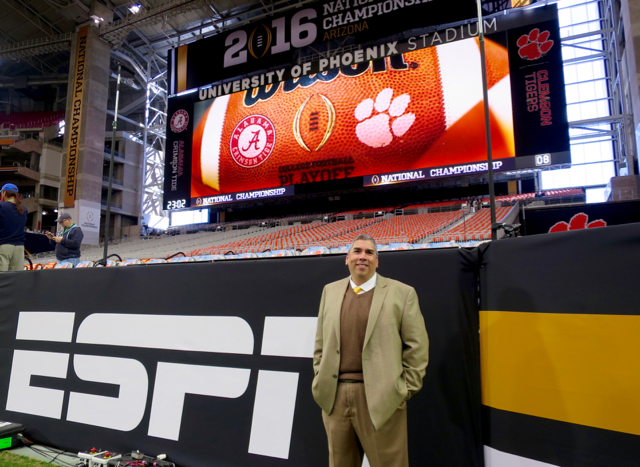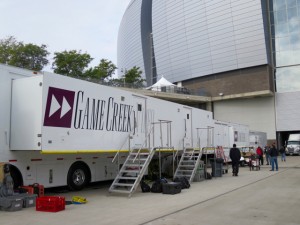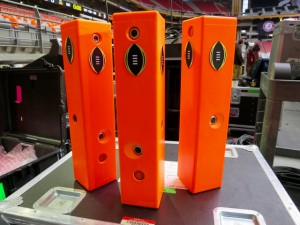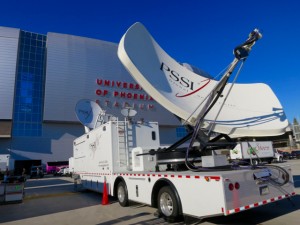Live From CFP Championship: ESPN’s Massive Efforts Eclipse Super Bowl Benchmarks
Story Highlights
ESPN’s coverage of college football during the past six months has put their production teams front and center at nearly 400 football games and 45 postseason events across three divisions of teams. “I’m proud of my team because the first challenge is dealing with that sheer volume of games and to be able to manage those events, get them on air successfully, and be ready for two semifinal games and the national championship,” says John LaChance, ESPN’s director of remote operations. “That’s a collective effort that took a lot of planning, and I think the team executed it very well. We have had a very smooth postseason, so now we want to extend that through Monday night.”
Monday night, of course, is the culmination of all those efforts, as ESPN will broadcast the 2016 College Football Playoff National Championship between the Clemson Tigers and Alabama Crimson Tide. Kickoff is set for 8:32 p.m. EST.

ESPN’s John LaChance says he is proud of the hardwork put in by the ESPN college football production team not only for tonight’s game but for the nearly 450 games produced this season.
This year’s championship will be played at University of Phoenix Stadium in Glendale, AZ, a facility that is used to hosting big games, as it has hosted two Super Bowls as well as the annual Fiesta Bowl. Next year, it will be home to the NCAA Men’s Basketball Final Four.
“The team here at the University of Phoenix Stadium is outstanding,” says LaChance.
Both the ESPN team and the stadium’s team worked closely together to make sure that not only were the camera and microphone cable runs laid properly, but also that the in-venue audio and video experience gets the most out of the crowd, which, in turn, makes for a better TV product.
“We trade feeds with them and they are a very good partner in making both shows work together, and we appreciate that,” says Derek Mobley, ESPN’s director for the game.
For more from the 2016 CFP National Championship Game:
Megacast Puts Innovations Front and Center
Pylon Cam Gets Full Deployment in Glendale
Van Wagner, Arizona Cardinals Unite To Rock University of Phoenix Stadium
SportsLabs Powers In-Stadium Mobile App
Fletcher Sports Supports ESPN With Robotics
In addition, both teams also had to make contingency plans in case the stadium’s main tenant, the NFL’s Arizona Cardinals, hosted a playoff game this same weekend.
But the Cardinals landed a bye, so all involved moved forward with Plan A, which is arguably the most ambitious plan ever for a single football game. First, there is a massive effort to offer top-notch game coverage; additionally, ESPN is creating 14 channels of additional content that will be available via ESPN3 and WatchESPN.

Game Creek Video has seven production trucks at University of Phoenix Stadium for ESPN’s coverage of the College Football Playoff National Championship Game.
Game Creek Video’s Glory A and B 53-foot expandable units are at the center of the game coverage. The equipment complement includes 65 cameras between the game coverage, GameDay, Megacast, and ESPN Deportes (not including 32 on the Pylon Cams) outfitted with Canon lenses (five 100x; nine 85x; 5 86x; and one 75x), 96 channels of EVS XT3 (in various 6-, 8-, and 12-channel configurations); and 64 channels of Evertz DreamCatcher. Vizrt and Sportvision gear will handle graphics needs, while Calrec audio consoles and Grass Valley production switchers will be at the core of mixing audio and video signals.
“We are taking the good things we do every week and not letting all the extra things distract,” says Mobley. “We’ll take what we normally do and do it better.”
All In On Pylon Cam
Highlights this year include the National Championship Game debut of Pylon Cam, a pylon for the end-zone corners that has a camera in each of its four sides and can provide comprehensive coverage of the goal line and sidelines near the end zone. The Pylon Cam system was tested during last year’s Championship Game and the technology made its official on-air debut for the past season of ESPN’s Monday Night Football.

Eight third-generation Pylon Cams will give ESPN 32 different angles of coverage.
“We actually have a third-generation pylon cam here, as it is slightly different than what is used on Monday Night Football,” says LaChance.
On Monday, the use of Pylon Cam will go to the next level with the addition of one on each corner of the end zone backlines as well as the goal lines.
“There will be 32 angles from the Pylon Cams that we can play back as replay and we can also take four of them live,” says Mobley.
This year’s game also will feature four I-MOVIX 4K cameras, with two on the far side and two on the near side.“We had several looks from them last year that were key to the production,” says Mobley.
Last year’s super slo-mo efforts relied on Sony F55 cameras, but this year those units have been replaced by six Sony HDC-4300 cameras with three operating in 6x mode and three operating in 4x mode. There are also two Sony HDC-2500 units operating in 2x mode.
“The 4300 is a gigantic gamechanger, as it is not locked into one playout speed,” says Mobley.
The trick for Mobley and the front-bench team might be figuring out how to get replays within the broadcast, given how quickly the Clemson Tigers run their offense. Keeping up with college teams that play quick is more difficult than keeping up with NFL teams that get to the line quickly for the next play.
“They are playing really fast, so you have to pay attention to not miss a snap. Alabama does some of the same things,” says Mobley. “So we might have some great looks but only chance to play back one.”
Get In the Game
Game Creek Video’s Spirit A and B will be home to the main telecast production with main audio, graphics, and the front bench area in Spirit A. Spirit B will be home to the EVS area, an edit suite, and the Sportvision team that operates the 1st and Ten marker.
Glory A will handle all of the POV and RF camera operations as well as audio mixing for ESPN Deportes and the game audio submix area. Glory B will be home to the Sounds of the Game Megacast channel (mixed on a DiGiCo audio board) as well as more robotic camera controls and four Evertz DreamCatcher replay systems with 16 channels each that will be used for the Pylon Cam operations.
Meanwhile, Larkspur will handle the Gameday pre- and post-game production; Discovery will produce the Taco Bell Megacast channel, and Game Creek’s Justice unit will also be on site for GameDay needs (and it also handled Media Day duties earlier in the week). Maverick, meanwhile, will remain at the downtown Fan Fest area for ESPN programming from that location.
Brian Nupnau, Game Creek Video EIC, says the biggest challenge is just the size of the show and the vast number of transmission paths. Game Creek Video’s staff will be out in full force, with 11 engineers on site to oversee the mobile units.

PSSI is on hand at the College Football Playoff National Championship to provide redundant satellite backup of the primary fiber transmission services provided by The Switch.
“Glory A will distribute camera signals to the other trucks and Spirit A has 24 separate transmission paths,” says Nupnau. “And we do have a backup plan to move all the production from Spirit to Glory A if needed.”
“The vendors like Game Creek and their technicians are all part of the story,” says LaChance, who says the key to the success all year has been the efforts of the ESPN staffers, freelancers, and related vendors. The Switch is providing fiber transmission services, DTAGS is handling encoding, and PSSI is on hand with a C-band satellite truck for backup.
“The one truck is redundant and has two C-band antennas backing up 41 outbound paths and 20 inbound paths,” says Brian Burney, ESPN, manager, remote traffic.
That any single production would need 41 outbound paths and 20 inbound paths shows just how quickly ESPN’s commitment to the College Football Playoff National Championship game is evolving. And given that this is only year two of a 10-year commitment, it seems destined to continue to mature, evolve, and grow.
“The massive size of what we did at the inaugural Championship last year was impressive, and we’ve come here and taken it another step forward,” says LaChance. “And chances are we’ll be having the same conversation next year when the game is held in Tampa.”
